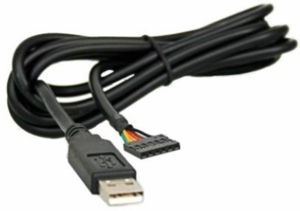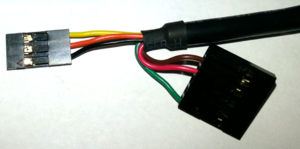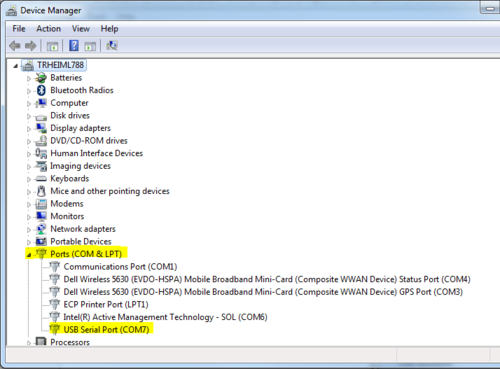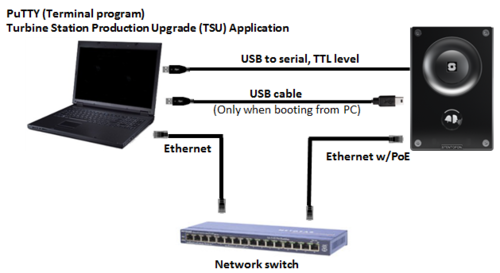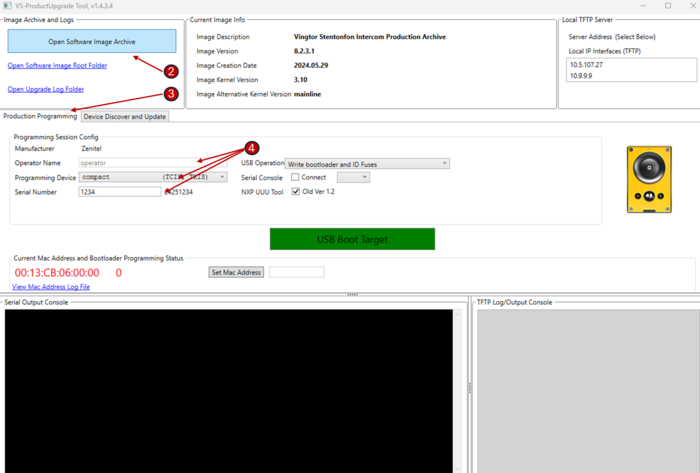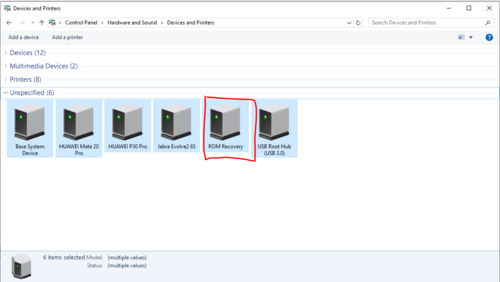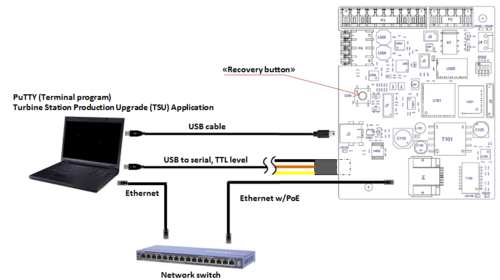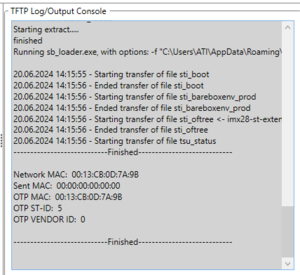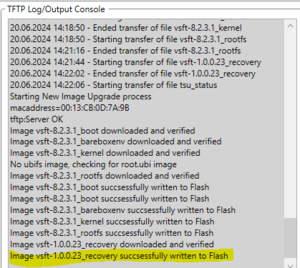Difference between revisions of "Turbine Stations - Image recovery"
From Zenitel Wiki
(→Phase two - Run full tftp image upgrade) |
(→Example using "DHCP Server for Windows") |
||
| (11 intermediate revisions by the same user not shown) | |||
| Line 1: | Line 1: | ||
| − | This article describes how | + | This article describes how to flash a new image on a Zenitel Turbine device ("Compact" and "Extended" versions based on iMX28 processor). |
= Requirements = | = Requirements = | ||
| Line 11: | Line 11: | ||
| − | == Optional | + | == Optional == |
The process can be run without these, but it helps monitoring the process. | The process can be run without these, but it helps monitoring the process. | ||
* A terminal emulator program. PuTTY is recommended | * A terminal emulator program. PuTTY is recommended | ||
| Line 43: | Line 43: | ||
| − | = Prepare the VS-ProductUpgrade application = | + | = Prepare the "VS-ProductUpgrade" application = |
*Make sure no other TFTP server is running on the PC. | *Make sure no other TFTP server is running on the PC. | ||
*Launch '''VS-ProductUpgrade''' application from Windows start menu ('''Start''' > '''Vingtor-Stentofon''' > '''VS-ProductUpgrade'''). | *Launch '''VS-ProductUpgrade''' application from Windows start menu ('''Start''' > '''Vingtor-Stentofon''' > '''VS-ProductUpgrade'''). | ||
| Line 73: | Line 73: | ||
Note! make sure you are not connected to other networks while doing this. | Note! make sure you are not connected to other networks while doing this. | ||
| − | Download and install from: http://www.dhcpserver.de/cms/ | + | * Download and install from: http://www.dhcpserver.de/cms/ |
| − | + | * Configure your computer with static ip 10.0.1.10. | |
| − | Configure your computer with static ip 10.0.1.10. | + | * Configure the DHCP config file |
Example of config file dhcpsrv.ini | Example of config file dhcpsrv.ini | ||
| Line 109: | Line 109: | ||
* ''Notice that parameter NEXTSERVER is set to 10.0.1.10 which in this example is the computer running the VS-ProductUpgrade application''. | * ''Notice that parameter NEXTSERVER is set to 10.0.1.10 which in this example is the computer running the VS-ProductUpgrade application''. | ||
* ''Configure the ROOT path as required}} | * ''Configure the ROOT path as required}} | ||
| + | |||
| + | * Start the DHCP Server by running the '''dhcpsrv.exe''' | ||
= Prepare USB boot from PC = | = Prepare USB boot from PC = | ||
| Line 129: | Line 131: | ||
== Phase one - Program the bootloader prepared for auto IP/tftp upgrade == | == Phase one - Program the bootloader prepared for auto IP/tftp upgrade == | ||
*In the prepared VS-ProductUpgrade Tool press the big green button '''USB Boot Target''' | *In the prepared VS-ProductUpgrade Tool press the big green button '''USB Boot Target''' | ||
| − | * Watch the progress in the "TFTP Log/Output Console" window | + | * Watch the progress in the "TFTP Log/Output Console" window in the VS-ProductUpgrade Tool |
[[File:Image PhaseOne.PNG|thumb|left|300px|Output on "TFTP Log/Output Console"]] | [[File:Image PhaseOne.PNG|thumb|left|300px|Output on "TFTP Log/Output Console"]] | ||
| Line 142: | Line 144: | ||
*Connect the "phase one prepared" board to the PoE switch (do not connect the USB cable) | *Connect the "phase one prepared" board to the PoE switch (do not connect the USB cable) | ||
*The upgrade should now start automatically. Observe the progress in the "TFTP Log/Output Console" window. This process takes a while (typically approx. 4 minutes), so be patient. | *The upgrade should now start automatically. Observe the progress in the "TFTP Log/Output Console" window. This process takes a while (typically approx. 4 minutes), so be patient. | ||
| − | |||
| − | + | [[File:Image PhaseTwo3.PNG|thumb|left|300px|Progress shown in the "TFTP Log/Output Console"]] | |
| − | + | <br style="clear:both;" /> | |
| − | + | ||
| − | + | * The process is finished when '''recovery successfully written to flash''' is displayed. | |
| − | + | ||
| − | + | ||
| − | + | The board will now reboot, and start in normal operational mode. The board can be accessed through its web interface. | |
| − | + | ||
| − | |||
| − | |||
| − | |||
| − | |||
| − | |||
| − | |||
| − | |||
| − | |||
| − | |||
| − | |||
| − | |||
| − | |||
| − | |||
| − | |||
| − | |||
| − | |||
| − | |||
| − | |||
[[Category: Turbine - Restore Factory Defaults and Software Upgrade]] | [[Category: Turbine - Restore Factory Defaults and Software Upgrade]] | ||
Revision as of 15:55, 20 June 2024
This article describes how to flash a new image on a Zenitel Turbine device ("Compact" and "Extended" versions based on iMX28 processor).
Contents
Requirements
- Download and install VS-Tools.msi. The PC application VS-ProductUpgrade is a part of this package. This software runs both a TFTP server, and USB boot of target.
- A DHCP server handing out TFTP address to Turbine board using DHCP Option 66 (TFTP server address)
- A USB Mini B plug cable.
- Access to the physical circuit board.
Optional
The process can be run without these, but it helps monitoring the process.
- A terminal emulator program. PuTTY is recommended
- A USB to Serial cable for serial connection from the PC to the Turbine Compact board
Preparation of the optional USB to Serial converter cable
The Turbine station has a TTL level serial interface to which we can connect during the upgrade process. For this purpose a USB to Serial converter cable can be used. Recommended cable is TTL-232R-3V3, available from Farnell.
This cable needs to be slightly modified as per photo below:
- Pin 1 = Black (GND)
- Pin 2 = Orange (Turbine RX)
- Pin 3 = Yellow (Turbine TX)
Insert the USB connector in the PC. The unit will now install itself. Make a note of which COM port number it is assigned to. You will also find it in the Device Manager. Baud rate: 115200.
Setup and connections
Prepare the "VS-ProductUpgrade" application
- Make sure no other TFTP server is running on the PC.
- Launch VS-ProductUpgrade application from Windows start menu (Start > Vingtor-Stentofon > VS-ProductUpgrade).
- Download the software image for Zenitel Devices based on iMX28. Image: vsft-prod-8.2.3.1.zip
- Load the software image using the Open Software Image Archive button.
- Activate tab Production Programming
- Insert input fields Operator Name, Programming Device and Serial Number.
Your application should look something like below programming a TCIS-1 Station:
Prepare the DHCP server
You can use any DHCP server, but you need to be able to configure DHCP option 66/Nextserver (TFTP server address) to point to the IP of the PC running VS-ProductUpgrade.
Example using "DHCP Server for Windows"
This is a simple and easy to use server that works good for this setup. Note! make sure you are not connected to other networks while doing this.
- Download and install from: http://www.dhcpserver.de/cms/
- Configure your computer with static ip 10.0.1.10.
- Configure the DHCP config file
Example of config file dhcpsrv.ini
[SETTINGS] IPPOOL_1=10.0.1.100-120 IPBIND_1=10.0.1.10 AssociateBindsToPools=1 Trace=1 DeleteOnRelease=0 ExpiredLeaseTimeout=3600 [GENERAL] LEASETIME=86400 NODETYPE=8 SUBNETMASK=255.255.255.0 NEXTSERVER=10.0.1.10 ROUTER_0=10.0.1.1 [DNS-SETTINGS] EnableDNS=0 [TFTP-SETTINGS] EnableTFTP=0 ROOT=C:\Programs\dhcpsrv2.5.2\wwwroot WritePermission=1 [HTTP-SETTINGS] EnableHTTP=0 ROOT=C:\Programs\dhcpsrv2.5.2\wwwroot

|
|
- Start the DHCP Server by running the dhcpsrv.exe
Prepare USB boot from PC
Use the USB Mini B plug cable.
- Disconnect the Ethernet cable from the station (you might leave USB to Serial converter cable connected, so you can view progress on PuTTY)
- Connect one end of the USB cable to the PC
- Push and hold the "Recovery button" on the station (switch S200), and keep it pressed for 5 sec while connecting the USB cable to the station (connector J2 on "Compact, J3 on "Extended")
- The PC should indicate new USB Device
- Connect the Ethernet cable to the Turbine station. Now you have the following setup: (The usb-to-serial cable is optional)
Run USB recovery programming of device(s)
When all above is prepared all is set to start the full clean programming of the device(s).
Phase one - Program the bootloader prepared for auto IP/tftp upgrade
- In the prepared VS-ProductUpgrade Tool press the big green button USB Boot Target
- Watch the progress in the "TFTP Log/Output Console" window in the VS-ProductUpgrade Tool
- If serial cable is connected you can also observe the progress and see status in the terminal program
- This programming will finish after just a couple of seconds. You might get a warning message - if so, ignore this message.
- Remove USB and Ethernet cable.
Phase two - Run full tftp image upgrade
- Have the prepared VS-ProductUpgrade running
- Connect the "phase one prepared" board to the PoE switch (do not connect the USB cable)
- The upgrade should now start automatically. Observe the progress in the "TFTP Log/Output Console" window. This process takes a while (typically approx. 4 minutes), so be patient.
- The process is finished when recovery successfully written to flash is displayed.
The board will now reboot, and start in normal operational mode. The board can be accessed through its web interface.


